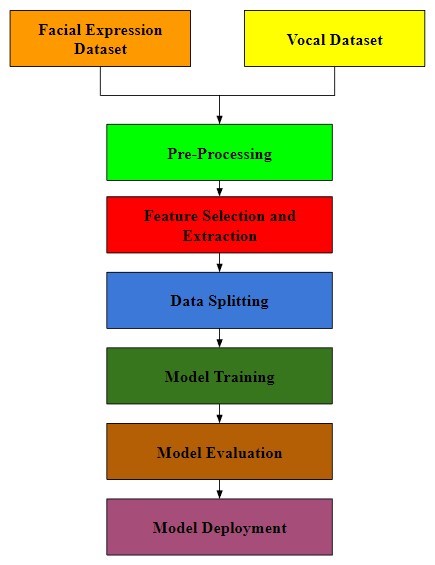An Automated System for Depression Detection Based on Facial and Vocal Features
Main Article Content
Abstract
Diagnosing depression is a challenge due to the subjective nature of traditional tools like questionnaires and interviews. Researchers are exploring alternative methods for detecting depression, such as using facial and vocal features. This study investigated the potential of facial and vocal features for depression detection using two datasets: images of facial expressions with emotion labels, and a vocal expression dataset with positive and negative words. Four deep-learning models were evaluated for depression detection from facial expressions, and two traditional machine-learning models were trained for sentiment analysis on the vocal expression dataset. The CNN model performed best for facial expression analysis, while the Naive Bayes model performed best for vocal expression analysis. The models were integrated into a web application for depression analysis, allowing users to upload a video and receive an analysis of their facial and vocal expressions for signs of depression. This study demonstrates the potential of using facial and vocal features for depression detection and provides insight into the performance of different machine learning algorithms for this task. The web application has the potential to be a useful tool for individuals monitoring their mental health and may support mental health professionals in their clinical assessments of depression.
Article Details
References
Anastasia and P. Simos, "Automatic Assessment of Depression Based on Visual Cues: A Systematic Review," IEEE Transactions on Affective Computing, vol. 10, no. 4, pp. 445-470, 2019.
M. L. Joshi and N. Kanoongo, "Depression detection using emotional artificial intelligence and machine learning: A closer review," Materials Today: Proceedings, vol. 58, pp. 217-226, 2022.
A. Castiglione and S. Hossain, "Impact of Deep Learning Approaches on Facial Expression Recognition in Healthcare Industries," EEE Transactions on Industrial Informatics, vol. 18, no. 8, pp. 5619-5627, 2022.
A. V. Savchenko and Savchenko, "Classifying Emotions and Engagement in Online Learning Based on a Single Facial Expression Recognition Neural Network," IEEE Transactions on Affective Computing, vol. 13, no. 4, pp. 2132-2143, 2022.
Dr. Govind Shah. (2017). An Efficient Traffic Control System and License Plate Detection Using Image Processing. International Journal of New Practices in Management and Engineering, 6(01), 20 - 25. Retrieved from http://ijnpme.org/index.php/IJNPME/article/view/52
A. F. Yaseen and Shaukat, "Emotion Recognition from Facial Images using Hybrid Deep Learning Models," in 2022 2nd International Conference on Digital Futures and Transformative Technologies (ICoDT2), 2022.
M. Z. Asghar, "An efficient deep learning technique for facial emotion recognition," Multimedia Tools and Applications, vol. 81, no. 2, pp. 1573-7721, 2022.
Yuliang, X. Meng and Gao, "Emotion Recognition Based On CNN," in 2019 Chinese Control Conference (CCC), 2019.
E. Pranav and Kamal, "Facial Emotion Recognition Using Deep Convolutional Neural Network," in 2020 6th International Conference on Advanced Computing and Communication Systems (ICACCS), 2020, pp. 317-320.
Liu and Lingling, "Human Face Expression Recognition Based on Deep Learning-Deep Convolutional Neural Network," in 2019 International Conference on Smart Grid and Electrical Automation (ICSGEA), 2019, pp. 221-224.
Wankhade and Mayur, "A survey on sentiment analysis methods, applications, and challenges," Artificial Intelligence Review, vol. 55, no. 7, p. 5731–5780, 2022.
"Sentiment analysis and Automatic Emotion Detection Analysis of Twitter using Machine Learning Classifiers," International Journal of Mechanical Engineering, vol. 7, no. 2, p. 11, 2022.
Kanna, D. R. K. ., Muda, I. ., & Ramachandran, D. S. . (2022). Handwritten Tamil Word Pre-Processing and Segmentation Based on NLP Using Deep Learning Techniques. Research Journal of Computer Systems and Engineering, 3(1), 35–42. Retrieved from https://technicaljournals.org/RJCSE/index.php/journal/article/view/39
T. Vaidya and R. Yeole, "Deep Learning-Based Early Depression Detection using Social Media," INTERNATIONAL JOURNAL OF INNOVATIVE RESEARCH IN TECHNOLOGY, vol. 9, no. 10, pp. 974-977, 2023.
Zhong and Shan, "Expression Recognition Method Using Improved VGG16 Network Model in Robot Interaction," Journal of Robotics, vol. 2021, p. 9, 2021.
H. Abdullahi and Sharif, "Facial expression recognition using deep learning," in AIP Conference Proceedings, 2021.
J. Ju and Q. Hua, "A-MobileNet: An approach of facial expression recognition," Alexandria Engineering Journal, vol. 61, no. 6, pp. 4435-4444, 2022.
F. Arefin, S. R. Das and Shanto, "Depression Detection Using Convolutional Neural Networks," 2021 IEEE International Conference on Signal Processing, Information, Communication & Systems (SPICSCON), pp. 9-13, 2021.
García, A., Petrovi?, M., Ivanov, G., Smith, J., & Cohen, D. Enhancing Medical Diagnosis with Machine Learning and Image Processing. Kuwait Journal of Machine Learning, 1(4). Retrieved from http://kuwaitjournals.com/index.php/kjml/article/view/143
S. Gide and S. Ghatte, "Depression Prediction using BERT and SVM," International Research Journal of Engineering and Technology, vol. 9, no. 3, pp. 2013-2016, 2022.
P. P. Surya and B. Subbulakshmi, "Sentimental Analysis using Naive Bayes Classifier," 2019 International Conference on Vision Towards Emerging Trends in Communication and Networking (ViTECoN), Vols. 9-13, 2021.
Shalini, A. K. ., Saxena, S. ., & Kumar, B. S. . (2023). Designing A Model for Fake News Detection in Social Media Using Machine Learning Techniques. International Journal of Intelligent Systems and Applications in Engineering, 11(2s), 218 –. Retrieved from https://ijisae.org/index.php/IJISAE/article/view/2620

